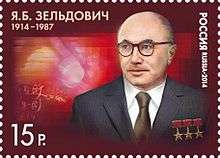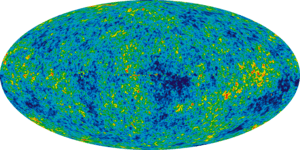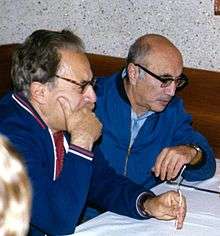Yakov Zeldovich
Yakov Borisovich Zeldovich ForMemRS[1] (Belarusian: Я́каў Бары́савіч Зяльдо́віч, Russian: Я́ков Бори́сович Зельдо́вич; 8 March 1914 – 2 December 1987), also known as YaB,[2] was a Soviet physicist, who is known for his prolific contributions in cosmology and the physics of thermonuclear and hydrodynamical phenomena.[3]
Yakov Borisovich Zeldovich | |
|---|---|
 Zeldovich on a 2014 Russian postage stamp | |
| Born | 8 March 1914 |
| Died | 2 December 1987 (aged 73) |
| Resting place | Novodevichy Cemetery, Moscow |
| Citizenship | Soviet Union |
| Alma mater | Saint Petersburg State University |
| Known for | Soviet atomic bomb project Hawking-Zeldovich radiation Sunyaev–Zeldovich effect Zeldovich equation of state Zeldovich approximation Zeldovich number ZND detonation model Shvab–Zeldovich formulation Self-similar solution of the second kind Zeldovich–Liñán model Harrison-Zeldovich spectrum Zeldovich mechanism Zeldovich streaming model Activation energy asymptotics Zeldovich pancake |
| Awards | Hero of Socialist Labor (1949,1954,1956) |
| Scientific career | |
| Fields | Physics Combustion Astrophysics |
| Institutions | Institute of Chemical Physics Moscow State University Sternberg Astronomical Institute |
| Doctoral students | Sergei Kopeikin |
| Other notable students | Rashid Sunyaev Roman Juszkiewicz Igor Dmitriyevich Novikov Sergei Shandarin Alexei Starobinsky Vladimir M. Lipunov Victor Shvartsman |
| Part of a series on | ||||
| Physical cosmology | ||||
|---|---|---|---|---|
 | ||||
|
Early universe
|
||||
|
Expansion · Future |
||||
|
Components · Structure
|
||||
| ||||
From 1943, Zeldovich played a crucial role in the development of the Soviet Union's nuclear bomb project. In 1963, he returned to academia to embark on pioneering contributions on the fundamental understanding of the thermodynamics of black holes and expanding the scope of cosmology.[4]
Biography
Early life and education
Yakov Zeldovich was born into a Belarusian Jewish family in his grandfather's house in Minsk, Belarusian region in Russia, on March 8 1914.[5] However, in mid-1914, the Zeldovich family moved to St. Petersburg. They resided there until August 1941, when the family was evacuated together with the faculty of the Institute of Chemical Physics to Kazan to avoid the Axis Invasion of the Soviet Union.[6]:301 They remained in Kazan until the summer of 1943, when Zeldovich moved to Moscow.[6]
His father, Boris Naumovich Zeldovich, was a lawyer; his mother, Anna Petrovna Zeldovich (née Kiveliovich), a translator from French to Russian, was a member of the Writer's Union.[6] Despite being born into a devoted and religious Jewish family, Zeldovich was an "absolute atheist".[7][8]
Zeldovich was an autodidact. He was regarded as having a remarkably versatile intellect, and during his life he explored and made major contributions to a wide range of scientific endeavors.[4] From a given opportunity in May 1931, he secured an appointment as a laboratory assistant at the Institute of Chemical Physics of the USSR Academy of Sciences, and remained associated with the institute for the remainder of his life.[6][4]:301 As a laboratory assistant, he received preliminary instructions on the topics involved in the physical chemistry and built up his reputation among his seniors at the Institute of Chemical Physics.[6]:301
From 1932 to 1934, Zeldovich attended the undergraduate courses on physics and mathematics at the Leningrad State University (now St. Petersburg State University), and later attended the technical lectures on introductory physics at the Leningrad Polytechnic Institute (now Peter the Great St. Petersburg Polytechnic University).[6]:301[9]:2–5
In 1936, he was successful in his candidacy for the Candidate of Science degree (a Soviet equivalent of PhD), having successfully defended his dissertation on the topic of the "adsorption and catalysis on heterogeneous surfaces".[6]:301 The centrality of his thesis focused towards the research on the Freundlich (or classical) adsorption isotherm, and Zeldovich discovered the theoretical foundation of this empirical observation.[1]
In 1939, Zeldovich prepared his dissertation based on the mathematical theory of the physical interpretation of nitrogen oxidation, and successfully received the Doctor of Science in mathematical physics when it was reviewed by Aleksandr A. Freiman.[10]:39–40 Zeldovich discovered its mechanism, known in physical chemistry as the thermal NO
x mechanism or Zeldovich mechanism.
Soviet atomic bomb program
Zeldovich is regarded as a secret principal of the Soviet nuclear weapons project; his travels abroad were highly restricted, to Eastern Europe, under close Soviet security.[11]:198–199 Soon after the discovery of nuclear fission (by German chemist Otto Hahn in 1939) Russian physicists had begun investigating the scope of nuclear-fission physics, and undertook seminars on that topic; Igor Kurchatov and Yulii Khariton were engaged in 1940.[6]:79–80
In May 1941, Zeldovich worked with Khariton in constructing a theory, on the kinetics of nuclear reactions in the presence of the critical conditions.[6]:81 The work of Khariton and Zeldovich was extended into theories of ignition, combustion and detonation; these accounted for features which had not previously been correctly predicted, observed, nor explained.[6]:82[4] The modern theory of detonation accordingly is called the Zeldovich-von Neumann-Dohring, or ZND, theory, and its development involved tedious fast neutron calculations; this work had been delayed, due to the German invasion of the Soviet Union, which obstructed progress on findings that in June 1941 would be de-classified.[6]:82 In 1942, Zeldovich was relocated to Kazan, and tasked by the People's Commissariat of Munitions to carry out work on conventional gun powders to be supplied to the Soviet Army, while Khariton was asked to design the new types of conventional weaponry.[6]:87–88
In 1943, Joseph Stalin decided to launch an arms build-up of nuclear weapons, under the charge of Igor Kurchatov; the latter requested Stalin to relocate Zeldovich and Khariton to Moscow, in the nuclear weapons program.[6]:87–88 Zeldovich joined Igor Kurchatov's small team at this secretive laboratory in Moscow to launch the work on the nuclear combustion theory, and became a head of the theoretical department at the Arzamas-16 in 1946.[4]
With Isaak Gurevich, Isaak Pomeranchuk, and Khariton, Zeldovich prepared a scientific report on the feasibility of releasing energy through nuclear fusion triggered by an atomic explosion, and presented it to Igor Kurchatov.[4] Zeldovich had benefitted from physical and technical knowledge provided by German physicist Klaus Fuchs and American physicist Theodore Hall, who each had worked on the American Manhattan Project to develop nuclear weapons.[6]:89–90
In 1949, Zeldovich led a team of physicists that conducted the first nuclear test, the RDS-1, based roughly on the American design obtained through the atomic spies in the United States, though he continued his fundamental work on explosive theory.[6]:89–90 Zeldovich then began working on modernizing the successive designs of the nuclear weapon and initially conceived the idea of hydrogen bomb to Andrei Sakharov and others.[6]:89–90 In the course of his work on nuclear weapons, Zeldovich did ground-breaking work in radiation hydrodynamics, and the physics of matter at high pressure. Between his younger colleagues in Sarov, which worked in this area was Mihail Aleksandrovich Podurets, which is known also for his contribution to the theory of gravitational collapse [4][12]
Between 1950 and 1953, Zeldovich performed calculations necessary for the feasibility of the hydrogen bomb that were verified by Andrei Sakharov, although the two groups worked in parallel on the development of the thermonuclear fusion. However, it was Sakharov that radically changed the approach to thermonuclear fusion, aided by Vitaly Ginzburg in 1952.[13]:56–57 He remained associated with the nuclear testing program, while heading the experimental laboratories at Arzamas-16 until October 1963, when he left for academia.[10]:38–40
Academia and cosmology
In 1952, Zeldovich began work in the field of elementary particles and their transformations. He predicted the beta decay of a pi meson. Together with S. Gershtein he noticed the analogy between the weak and electromagnetic interactions, and in 1960, he predicted the muon catalysis (more precisely, the muon-catalysed dt-fusion) phenomenon. In 1977, Zeldovich together with Fyodor Shapiro was awarded the Kurchatov Medal, the highest award in nuclear physics of the USSR. The citation was "for prediction of characteristics of ultracold neutrons, their detection and investigation". He was elected academician of the USSR Academy of Sciences on 20 June 1958. He was a head of division at the Institute of the Applied Mathematics of the USSR Academy of Sciences from 1965 until January 1983.

In early 1960s, Zeldovich started working in astrophysics and physical cosmology. In 1964, he and independently Edwin Salpeter were the first to suggest that accretion discs around massive black holes are responsible for the huge amounts of energy radiated by quasars.[14][15] From 1965, he was a professor at the Department of Physics of the Moscow State University and a head of the division of Relativistic Astrophysics at the Sternberg Astronomical Institute. In 1966, he and Igor Novikov was the first to propose searching for black hole candidates among binary systems in which one star is optically bright and X-ray dark and the other optically dark but X-ray bright (the black hole candidate).[16]
Zeldovich worked on the theory of the evolution of the hot universe, the properties of the microwave background radiation, the large-scale structure of the universe, and the theory of black holes. He predicted, with Rashid Sunyaev, that the cosmic microwave background should undergo inverse Compton scattering. This is called the Sunyaev-Zeldovich effect, and measurements by telescopes such as the Atacama Cosmology Telescope and the South Pole Telescope has established it as one of the key observational probes of cluster cosmology. Zeldovich contributed sharp insights into the nature of the large scale structure of the universe, in particular, through the use of Lagrangian perturbation theory (the Zeldovich approximation) and the application of the Burgers' equation approach via the adhesion approximation.
Black hole thermodynamics
Zeldovich played a key role in developing the theory of black hole evaporation due to Hawking radiation. Zeldovich and Charles Misner concomitantly predicted the possibility of particles generation by rotating Kerr black holes in 1971, 1972. Before, In 60-th Zeldovich predicted that Kerr black holes should split emission lines of photons as in a Zeeman effect [17] During Stephen Hawking's visit to Moscow in 1973, Soviet scientists Zeldovich and Alexei Starobinsky showed Hawking that, according to the quantum mechanical uncertainty principle, rotating black holes should create and emit particles.[18]
Family
With his wife, Varvara Pavlovna Konstantinova, Yakov Zeldovich had a son and two daughters who were also physicists: son – Boris Yakovlevich Zeldovich;[19] daughters – Olga Yakovlevna Zeldovich and Marina Yakovlevna Zeldovich.
Zeldovich also had a daughter, Annushka, with O.K. Shiryaeva.[20]
Publications
Books
- Zel'dovich Ya.B., Ruzmaikin A.A. (2015). Dynamo Problems in Astrophysics. Cambridge Scientific Publishers. ISBN 978-1908106445.
- Zel'dovich Ya.B., Novikov I.D. (2014). Stars and Relativity. Dover.
- Zel'dovich Ya.B., Raizer Yu.P. (2012). Physics of Shock Waves and High-Temperature Hydrodynamic Phenomena, Volume 1. Dover.
- Zel'dovich Ya.B., Raizer Yu.P. (2012). Physics of Shock Waves and High-Temperature Hydrodynamic Phenomena, Volume 2. Dover.
- Perelomov A. M., Zel'dovich Ya.B. (1999). Quantum Mechanics: Selected Topics. World Scientific. ISBN 978-9810235505.
- Zel'dovich Ya.B. (1993). Selected Works of Yakov Borisovich Zeldovich: Particles, Nuclei, and the Universe. Princeton University Press. ISBN 978-0691087429.
- Zel'dovich Ya.B. (1992). Selected Works of Yakov Borisovich Zeldovich: Chemical Physics and Hydrodynamics. Princeton University Press. ISBN 978-0691085944.
- Zel'dovich Ya.B. (1992). My Universe: Selected Reviews. Routledge. ISBN 978-3718650040.
- Zel'dovich Ya.B., Ruzmaikin A.A., Sokoloff D.D. (1990). Magnetic Fields in Astrophysics. Gordon & Breach Science Pub. ISBN 978-0677223308.CS1 maint: multiple names: authors list (link)
- Zel'dovich Ya.B., Ruzmaikin A.A., Sokoloff D.D. (1990). The Almighty Chance. World Scientific. ISBN 978-9971509163.CS1 maint: multiple names: authors list (link)
- Zel'dovich Ya.B., Barenblatt G., Librovich V.B., Makhviladze G.M. (1985). The Mathematical Theory of Combustion and Explosions. Consultants Bureau. ISBN 978-0306109744.CS1 maint: multiple names: authors list (link)
- Zel'dovich Ya.B., Pilipetsky N.F., Shukunov V.V. (1985). Principles of Phase Conjugation. Springer. ISBN 978-3-662-13573-0.CS1 maint: multiple names: authors list (link)
- Zel'dovich Ya.B., Novikov I.D. (1983). Relativistic Astrophysics: The Structure and Evolution of the Universe vol 2. University of Chicago Press. ISBN 978-0226979571.
- Zel'dovich Ya.B., Novikov I.D. (1971). Relativistic Astrophysics: Stars and Relativity vol 1. University of Chicago Press. ISBN 978-0226979557.
- Zel'dovich Ya.B., Raizer Yu.P. (1968). Elements of Gasdynamics and the Classical Theory of Shock Waves. Academic Press.
- Zel'dovich Ya.B., Kompaneets A.S. (1960). Theory of Detonation. Academic Press.
- Zel'dovich Ya.B., Yaglom I.M. (1988). Higher mathematics for beginning physicists and engineers. Prentice Hall. ISBN 978-0133876482.
Awards and honors
Igor Kurchatov called him a "genius" and Andrei Sakharov named him "a man of universal scientific interests." Stephen W. Hawking once said to Zeldovich: "before I met you, I believed you to be a 'collective author', like Bourbaki."
- Dirac Medal of the ICTP (1985)
- Bruce Medal (1983)
- Gold Medal of the Royal Astronomical Society (1984).
- Kurchatov Medal (1977)
- Three times Hero of Socialist Labor (1949, 1953, 1957)
- Stalin Prize (1943, 1949, 1951, 1953)
- Lenin Prize (1957)
- Three Orders of Lenin (1949, 1962, 1974)
- Two Orders of the Red Banner of Labour (1945,1964)
- Order of the October Revolution (1962)
- An asteroid 11438 Zeldovich was named in his honor in 2001.
References
- Ginzburg, V. L. (1994). "Yakov Borissovich Zeldovich. 8 March 1914–2 December 1987". Biographical Memoirs of Fellows of the Royal Society. 40: 430–441. doi:10.1098/rsbm.1994.0049.
- "YaB-100 - Homepage". master.sai.msu.ru. sai-msu. Retrieved 18 April 2017.
- Ya. B. Zel'dovich and Yu. P. Raizer ; ed. by Wallace D. Hayes and Ronald F. Probstein (2002). Physics of shock waves and high-temperature hydrodynamic phenomena (Reprod. ed.). Mineola: N.Y. ISBN 0-486-42002-7.
- Sublette, Carey (1 May 2002). "Yakov Zel'dovich". nuclearweaponarchive.org. nuclear weapon archives. Retrieved 17 April 2017.
- "This day in Jewish history / A self-taught nuclear physicist is born". Haaretz. 8 March 2013. Retrieved 8 November 2013.
- Sunyaev, edited by R.A. (2004). "Childhood and School days" (google books). Zeldovich Reminiscences (1 ed.). London: CRC Press. p. 370. ISBN 9780203500163. Retrieved 17 April 2017.CS1 maint: extra text: authors list (link)
- Zel'dovich, Yakov Borisovich (2004). Sunyaev, R.A. (ed.). Zeldovich: Reminiscences. CRC Press. p. 69. ISBN 9780415287906.
I think that you know me well enough: I am an absolute atheist, and all days of the week are completely the same to me.
- Andrei Sakharov: Facets of a Life. Atlantica Séguier Frontières. 1991. p. 599. ISBN 9782863320969.
Speaking about religion, Yakov Borisovich could say unambiguously, "I'm an absolute atheist".
- Luca, edited by William A. Sirignano, Alexander G. Merzhanov, Luigi De (1997). "Biography" (google books). Advances in combustion science : in honor of Ya. B. Zel'dovich (173 ed.). Reston, Va.: American Institute of Aeronautics and Astronautics, Inc. p. 500. ISBN 9781600864261. Retrieved 18 April 2017.CS1 maint: extra text: authors list (link)
- Hargittai, Istvan (2013). Buried glory : portraits of Soviet scientists. New York: Oxford University Press. p. 320. ISBN 9780199985593. Retrieved 18 April 2017.
- Khalatnikov, Isaak M. (2012). From the atomic bomb to the Landau Institute autobiography. Top non-secret. Berlin: Springer, Khalatnikov. p. 210. ISBN 9783642275616. Retrieved 18 April 2017.
- Alex Gaina, My recollections about Yakov Zeldovich,
- Roberg, Jeffrey L. (1998). "The Hydrogen Bomb" (google books). Soviet Science under Control: The Struggle for Influence (1 ed.). U.S.: Springer. p. 153. ISBN 9781349262908. Retrieved 18 April 2017.
- Collin, Suzy (2006). "Quasars and Galactic Nuclei, a Half-Century Agitated Story". AIP Conf. Proc. 861: 587–595. arXiv:astro-ph/0604560. Bibcode:2006AIPC..861..587C. doi:10.1063/1.2399629.
- Zel'dovich, Ya.B. (1964). "The Fate of a Star and the Evolution of Gravitational Energy Upon Accretion". Sov. Phys. Dokl. 9: 195. Bibcode:1964SPhD....9..195Z.
- Thorne, Kip (1994). Black holes and time warps. pp. 308–309. ISBN 0-393-31276-3.
- Alex Gaina, My recollections about Yakov Zeldovich
- Hawking, Stephen (1988) A Brief History of Time, Bantam Books.
- "Professor Boris Zeldovich passes away at age 74". CREOL, The College of Optics & Photonics. 18 December 2018. Retrieved 27 December 2018.
- Hargittai, Istvan (2013). Buried Glory: Portraits of Soviet Scientists. Oxford University Press.
Further reading
- Overbye, D. Lonely Hearts of the Cosmos: The Scientific Quest for the Secret of the Universe. New York: HarperCollins, 1991.
- Annotated Bibliography for Yakov Borisovich Zel'dovich from the Alsos Digital Library for Nuclear Issues
- Yakov Borisovich Zel'dovich – page at the Moscow State University dedicated to Zeldovich
- Theory of combustion of unmixed gases – Zeldovich 1949, translated 1974
External links
